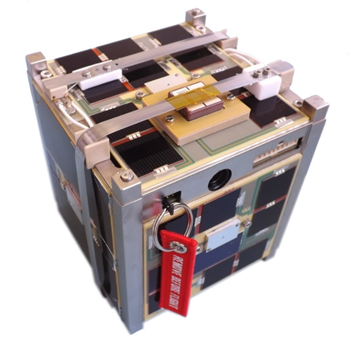BEESAT-9
Project Facts
| Project Name | Berlin Experimental and Educational Satellite (BEESAT-9) |
| Contact Person | Dipl.-Ing. Sascha Weiß |
| Funded by | Federal Ministry of Economy and Technology |
| Grant No. | 50 RM 1229 |

A second flight model is to be launched as part of the BEESAT-4 project. Under the name BEESAT-9, the engineering model of BEESAT-4 was modified and prepared for operations in space.
The primary mission objective is to implement a precise position and orbit determination package and to verify it in orbit. The GPS receiver GNSS200 from Hyperion Technologies is used for this purpose. This receiver is particularly well suited for 1U-CubeSats, since the energy consumption is low (max. 150mW), the mass small (approx. 1.6g) and also the occupied volume (20x15x3mm³) is minimal. Furthermore, the time to reach a valid navigation solution is very short (approx. 30s). This is particularly interesting for a non-continuous operation.
Similar to BEESAT-2 and -4, there will be a camera on board. The sensor will be the same, but a new lens will be used, which will allow a larger area per image to be captured. The Field of View would increase to 30°x23° compared to BEESAT-4 (23°x17°) with the same pixel resolution of 1600x1200 pixels.
The BEESAT-9 mission will also be used for a technology demonstration of a pico-fluid dynamic actuator (pFDA). This is integrated on the newly developed payload board and significantly increases the agility of the attitude control. During the mission, the pFDA will be integrated into the attitude control and all actuators will be used to align the satellite.
BEESAT-9 was launched into a polar orbit at an altitude of 530 km on July 5, 2019. The launch was organized by the Berlin based company EXOLAUNCH, which is also responsible for the deployment containers and their control. EXOLAUNCH was founded in 2010 by scientific employees of the TU Berlin and has been in close cooperation with the TU since then. The BEESAT-9 team would like to thank EXOLAUNCH very much for the launch opportunity and for the excellent service during the launch campaign.
During the first weeks of operation, all subsystems are checked for correct functionality. The routine phase then starts with the regular operation of the payloads. The entire operating phase of the satellite should last at least one year before the satellite is used for teaching purposes.

